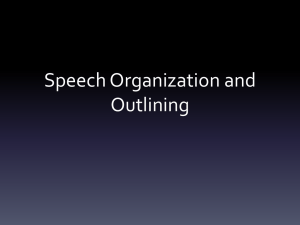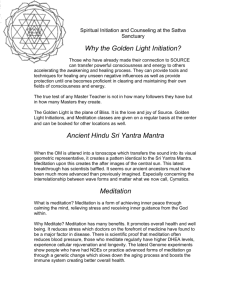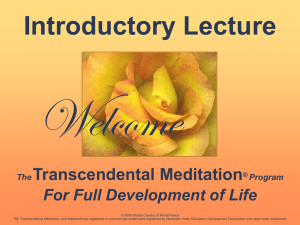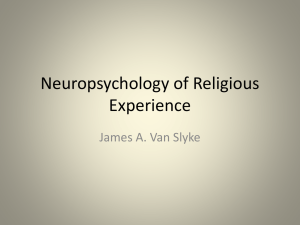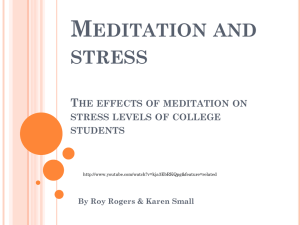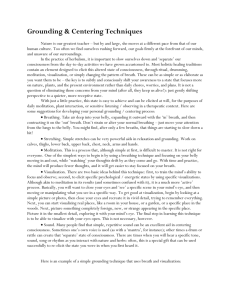6. Other Meditations
advertisement
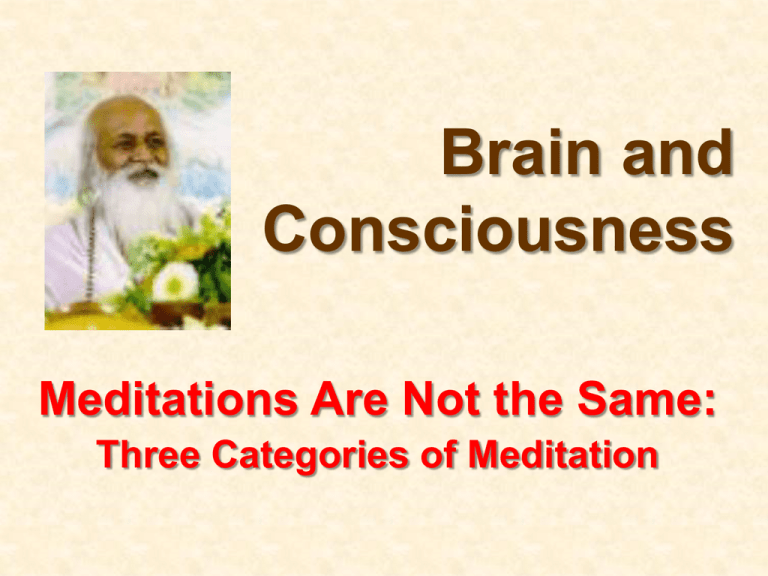
Brain and Consciousness Meditations Are Not the Same: Three Categories of Meditation Timeline: 7:45 – 9:00 Sun Sept Sept Monday Tuesday 11: Paradigms Wed Thursday Friday Sat 13: Brain Development Mongolia Conference Sept Yom Kippur 27: Sleeping Oct 2: Science and Pseudoscience 4: Other Meditations Oct 9: Cosmic Consciousness 28: TM and TC Drfredtravis.com-> Presentations and Videos-> Power Points->Brain and Consciousness for lecture power points Wholeness The procedures of different meditations are different, and so activate different brain areas. Experience of wakefulness at the basis of all experiences during TM practice activates the total brain. Class Reading “Focused Attention, Open Monitoring and Automatic SelfTranscending” Introduction Travis and Shear, 2010, Consciousness and Cognition, 19:1110-1119. Delta 0-4 Hz Deep sleep. During waking, if brain is strongly inhibited. Theta1 4-6 Hz Dreaming Theta2 6-8 Hz Memory processes and general internal processes Alpha1 8-10 Hz Inner wakefulness –higher cerebral metabolic rate (paradoxical alpha) Alpha2 10-12 Hz Brain modules primed but not active (idling)—lower CBR Beta1 16-20 Hz General processing Gamma 20-50 Hz Focused processing Cognitive Control Highest Focused Attention • Zen • Compassion Meditation Gamma (20-50 Hz) Open Monitoring Theta (6-8 Hz) Automatic SelfTranscending • Zazen • Mindfulness • Vipassana •Transcendental Meditation • Qicong Lowest Alpha1 (8-10 Hz) Travis and Shear, 2010, Consciousness and Cognition, 19:1110-1119. Phases within TM practice: Inward stroke versus pure consciousness 30 30 Subjects Inward Stroke Three Bell Rings 30 Pure Consciousness Travis and Wallace, 1997 Travis and Wallace, 1997 • "Meditation is not easy. It takes time and it takes energy. It also takes grit, determination, and discipline. It requires a host of personal qualities that we normally regard as unpleasant and like to avoid whenever possible. We can sum up all of these qualities in the American word gumption Meditation takes gumption." —Bhante Henepola Gunaratana, "Mindfulness in Plain English." Wisdom Publications, Boston, 2002 Cognitive Control Highest Lowest TM is Procedural Knowledge Class Reading “Focused Attention, Open Monitoring and Automatic SelfTranscending” Discussion Travis and Shear, 2010, Consciousness and Cognition, 19:1110-1119. SCI 18 “Any system that does transcend its emotional, intellectual, or perceptual activity will be Transcendental Meditation.” Maharishi, 18-8 Meditation procedures differ and associated EEG patterns differ; So effects from different meditation should also differ. Higher Connectivity Lower Connectivity A = Initial rest vs meditation (All) B = Final rest vs meditation (All) 13 Tibetan Buddhists, 15 QiGong, 14 Sahaja Yoga, 14 Ananda Marga Yoga, 15 Zen Meta analysis (Overvew): Psychological Measures Sedlmeier et al, 2012, Psychological Bulletin Effectiveness in Reducing Trait Anxiety Meta-Analysis TM Placebo Other Relaxation Relaxation Response Other Meditation PMR EMG-Biofeedback Mantra Meditation Concentration 0 .05 1 Journal of Clinical Psychology. 1989; 45:957-974 18 Effectiveness in Reducing BP Meta-Analysis TM Relaxation Response Other Meditation Systolic BP Diastolic BP Biofeedback All others 5 0 -5 -10 -15 Mm Hg .American Journal of Health Promotion. 1998:(5)297-298 Meta-analysis on SelfActualization Main Point Meditation practices differ in procedure, resulting EEG patterns, resulting neural imaging patterns and benefits. Thus, different meditation pracatices have different impacts on our life and our evolution. Group Exercise The Mayo Clinic website describes TM as: “… you use a mantra, such as a word, sound or phrase repeatedly silently, to narrow your conscious awareness and eliminate all thoughts from your mind. You focus exclusively on your mantra to achieve a state of perfect stillness and consciousness. How might you respond? Sedlmeier et al, 2012, Psychological Bulletin Effects of TM and MBSR on PTSD 1.60 1.40 Effect Size Sandardized Mean Difference (d) 1.20 1.00 0.80 0.60 0.40 0.20 0.00 TM (Brooks, 1985) TM (Rosenthal, 2011) MBSR (Bremner, 2011) MBSR (Kearny, 2011) Not for publication or distribution until the final meta-analysis is published. Copyright David Orme-Johnson, Ph.D, 2012



